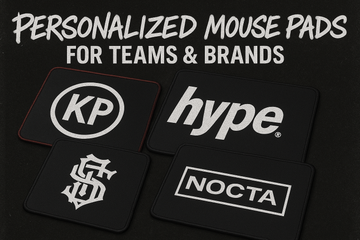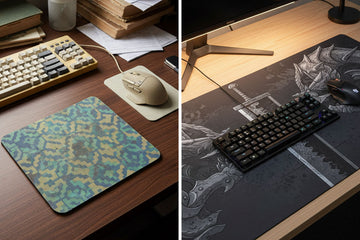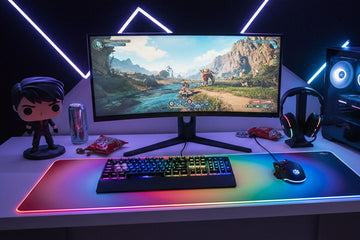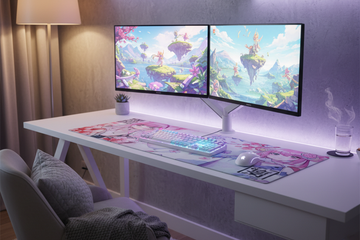When it comes to organizing a shared workspace or presenting a consistent brand image, small details often make a big difference. That's why this article explores the role of personalized mouse pads for teams & brands, offering general insights into their value, design choices, and practical benefits. We'll touch on why they're more than just desk accessories—covering everything from brand identity to workplace comfort—while giving you ideas on how to choose and customize one to suit your team or organization. Whether you're managing a corporate office, running a sports fan club, or leading a creative agency, the right mouse pad can subtly reinforce your message and bring cohesion to a group's visual presence. Understanding the balance between functionality, aesthetics, and durability is key, and it's something worth considering before placing an order.
We'll also look at the customization process in a way that's easy to follow, starting with selecting a design and ending with the unboxing experience. Along the way, factors like logo placement, color consistency, typography choices, and even mouse pad size and material will come into play. Different teams might prioritize different aspects—some may value comfort for long hours at the desk, while others may want bold designs that stand out in photos or events. By approaching the topic from both a creative and practical angle, you can make informed decisions that reflect your group's identity while ensuring the product lasts. This guide isn't about selling you a product—it's about understanding how such a simple item can influence brand cohesion and daily workflow.
Why a Personalized Mouse Pad Matters
A personalized mouse pad might seem like a small detail, but it can play a surprisingly important role in both professional and personal environments. For teams and brands, it's more than just a surface for your mouse—it's a subtle yet constant reminder of identity and purpose. Every time someone sits at their desk, the logo, colors, and design elements reinforce a sense of belonging. This consistency helps strengthen brand recognition internally and externally, especially when mouse pads are used in client meetings, at trade shows, or during online video calls. In creative or collaborative settings, they can also contribute to team spirit, acting as a shared visual cue that connects individual workspaces to the larger group identity. In short, a personalized mouse pad is not just an accessory; it's a functional branding tool that works quietly in the background every day.
Functionality is another reason these items matter. Standard mouse pads often prioritize price over performance, but a personalized option gives you control over quality and comfort. You can choose the right material—like a smooth fabric top for precision or a textured surface for better grip—based on how your team works. The right thickness can make a big difference for wrist comfort, especially for those who spend hours at their desk. And because the design is fully customizable, there's no need to compromise on aesthetics to get the performance you need. Personalized mouse pads for teams & brands combine practicality with a professional look, allowing them to serve dual purposes without extra effort. In a time where remote and hybrid work is common, small touches like these can help maintain a sense of connection across locations. They're also durable, meaning they'll keep delivering both comfort and brand value long after a typical office supply would need replacing. When you consider both the practical benefits and the subtle branding impact, it's clear why investing in personalized mouse pads makes sense for any team looking to strengthen identity while improving day-to-day usability.
Designing with Identity: Logo, Colors & Typography
Designing a personalized mouse pad starts with understanding how visual identity works. A well-placed logo, consistent colors, and carefully chosen typography can do more than just look nice—they can communicate values and create an immediate sense of recognition. For teams and brands, these elements are more than decorative; they are part of the language that tells people who you are. A mouse pad sits in a highly visible spot, so every detail counts. The logo should be clear at a glance, without unnecessary clutter. Colors need to match your existing brand palette, whether that means bold, attention-grabbing shades or subtle tones that convey professionalism. And typography, often overlooked in small items, matters just as much—it should be legible at the intended size and reflect the personality of the brand. The combination of these three elements forms a cohesive design that works quietly but effectively in reinforcing brand identity day after day.
But good design is not just about following brand guidelines—it's about making them work in the context of the product. A mouse pad offers a limited space, so proportion and balance are key.
Overly complex patterns or oversized logos can overwhelm, while designs that are too minimal may not make the desired impact. The aim is to create something that feels integrated with the workspace yet still stands out enough to be noticed. Personalized mouse pads for teams & brands are an opportunity to take the core elements of your identity and apply them in a functional, tactile form. Think about how colors interact with lighting on a desk, or how typography looks when viewed from different angles. Even the placement of a logo can change the overall feel—centered for formality, offset for a more dynamic look. These small decisions add up to a design that not only reflects your brand but also feels natural in the everyday setting where it will be used. In the end, designing with identity is about more than aesthetics—it's about creating a tool that blends branding with practicality, ensuring that every desk becomes a subtle extension of your message.
Choosing the Right Size & Material for Comfort
When creating a personalized mouse pad, design is only part of the story. Size and material choices are just as important because they directly affect how comfortable and practical the product will be in daily use. A mouse pad that looks great but feels awkward under the hand won't get much use, which means the branding impact is lost. The right size depends on how the workspace is set up and how the user works. Smaller mouse pads fit compact desks and minimal setups, keeping movement precise and controlled. Larger, extended pads offer more freedom for sweeping mouse movements and can even double as a surface protector for the entire desk area. Teams that work in design, gaming, or any task requiring high precision often prefer bigger pads for the extra room, while office environments might lean toward standard dimensions for space efficiency. This choice affects not only comfort but also the visibility of brand elements—larger pads naturally allow for more design space without crowding.
Material is the other side of the comfort equation. Cloth mouse pads are the most common for a reason: they're smooth, flexible, and provide just the right amount of resistance for everyday use. They're also lightweight and easy to roll up for transport, which is useful for teams that travel or work remotely. Hard-surface pads, often made from plastic or aluminum, offer more speed and durability but can be less forgiving on the wrist. There's also a middle ground—textured fabric tops on a rubber base—which balances control and comfort. The underside matters too; a non-slip rubber base keeps the pad stable, preventing constant adjustments during work. Personalized mouse pads for teams & brands benefit from this attention to material because the feel of the pad influences how often it's used. A pad that feels comfortable encourages consistent use, which in turn means the logo, colors, and design are always in view. Choosing the right combination of size and material ensures the product is not only visually aligned with the brand but also an item people actually want on their desk every day. In the end, these decisions help turn a simple accessory into a practical branding tool that works seamlessly in both form and function.
Customization Process: From Upload to Unboxing
The customization process for a mouse pad might seem straightforward at first glance, but a well-structured approach ensures that the final product matches expectations in both design and quality. It typically starts with the upload stage, where you provide the logo, images, or other brand elements that will form the basis of the design. This is the moment to double-check file quality—low-resolution images can result in blurry prints, so high-definition files are always the safer choice. Many design platforms offer real-time previews, letting you see how your personalized mouse pad will look before production begins. This stage is also where you can adjust the placement of elements, test different color options, or tweak typography to ensure it fits the space without overpowering the overall layout. Keeping the brand's visual identity in mind during this stage helps avoid mismatches and ensures the mouse pad feels like a natural extension of other branded materials.
Once the design is finalized, the production stage begins. The choice of printing method—such as sublimation for full-color, edge-to-edge designs or screen printing for simpler logos—can affect both the durability and the look of the mouse pad. This is also when the selected materials come into play, as the print process needs to match the surface type for optimal results. After printing, quality checks are essential. This step verifies color accuracy, ensures the design is aligned properly, and confirms that the finish matches the intended look. When everything passes inspection, the mouse pads are packaged. Good packaging matters more than most people think—it protects the product during shipping and sets the tone for the unboxing experience. For teams and brands, that first impression can reinforce the value of the item. Whether the mouse pads are being distributed in bulk at an office or handed out individually at an event, the transition from design upload to unboxing is more than a sequence of steps—it's a process that determines whether the product will be both functional and representative of the brand. Paying attention to each stage helps ensure that personalized mouse pads for teams & brands arrive ready to be used and appreciated, with the quality and design exactly as envisioned.
Perfect for Teams, Fans & Brands
Personalized mouse pads have a versatility that makes them suitable for a wide range of groups, from corporate teams to fan communities. For teams, they provide a simple yet effective way to create a sense of unity. When everyone uses the same design, featuring the company's logo, colors, and typography, it builds a shared visual identity that carries across meetings, desks, and even remote work setups. This consistency is not only good for internal morale but also for external perception—clients, visitors, and partners see a coordinated, professional image. For fans, the appeal lies in personal connection. A mouse pad can carry artwork, slogans, or imagery tied to a sports club, music group, or game, offering a daily reminder of the community they belong to. And for brands, these pads work as functional merchandise, blending utility with long-term visibility. Because they sit in a high-use area, they keep the brand front and center without being intrusive.
The strength of personalized mouse pads for teams & brands is in how they bridge practicality and identity. They are lightweight, easy to distribute, and useful in almost any setting—offices, home desks, gaming setups, and event booths. For teams, they can double as onboarding gifts, making new members feel included right away. For fan communities, they can be part of limited-edition drops, creating excitement and exclusivity. Brands can even use them as giveaways at trade shows or include them in promotional kits, knowing they're more likely to be kept and used than paper-based marketing materials. And because they can be customized in size, material, and design, they adapt to different needs without losing their core function. Whether it's a minimal, logo-only look for a law firm or a bold, full-color graphic for a gaming team, the underlying purpose is the same: to give people something they'll use daily while keeping the identity it represents in constant view. In this way, personalized mouse pads become more than just desk accessories—they become everyday touchpoints that strengthen connections, whether to a workplace, a passion, or a brand story.
Durability and Quality: Long-Lasting Performance
Durability and quality are at the core of any good personalized mouse pad. While the design catches the eye, it's the performance over time that determines whether the product truly delivers value. A mouse pad used daily is exposed to constant friction, hand oils, occasional spills, and environmental factors like sunlight or humidity. If it's poorly made, the edges can fray, the surface can wear down, and colors can fade within months. This not only impacts usability but also weakens the branding impact. That's why the choice of materials and production techniques is crucial. High-quality cloth pads, for example, often use stitched edges to prevent unraveling and a tightly woven surface to maintain a smooth glide for the mouse. Hard-surface pads might rely on protective coatings to resist scratches and maintain print clarity. These decisions affect both how the mouse pad feels in use and how well it holds up after months or even years of regular handling.
For personalized mouse pads for teams & brands, longevity has added importance because they represent an ongoing connection between the user and the identity printed on them. A pad that stays vibrant and functional reinforces brand recognition over time, while one that wears out too quickly can send the opposite message. Print quality plays a big role here—dye-sublimation printing, for example, embeds the design into the fabric, making it resistant to fading and peeling. The base also matters: a strong, non-slip rubber layer ensures the pad stays in place without curling at the edges. Even small details like water-resistant coatings can make a difference, protecting the surface from coffee spills or cleaning sprays. By investing in durable construction and quality materials, teams and brands can ensure their mouse pads are not just a temporary touchpoint but a lasting part of the user's workspace. Over time, this reliability turns the pad into more than a branded item—it becomes a daily tool that continues to serve its purpose without losing the visual identity it was designed to showcase.
How to Order from Padloom: A Step-by-Step Guide
Ordering personalized mouse pads from Padloom is a straightforward process, but knowing each step ensures you get exactly what you envisioned. It begins with selecting the mouse pad style that best suits your needs—whether that's a compact pad for limited desk space, an extended pad that covers the length of a keyboard, or something in between. Once you've chosen the base style, the next step is design selection. This is where you upload your logo, artwork, or brand elements. High-resolution files are important here; they guarantee sharp, clear printing without pixelation. Padloom's online customization tool allows you to adjust placement, test background colors, and preview the final look before committing. This stage is also the time to make choices about size, material, and edge finishes. For example, you might opt for stitched edges for durability or a specific surface texture for better mouse control. Taking the time to review these details helps avoid surprises later.
After you're satisfied with the design, the order moves into confirmation and production. Padloom provides a final proof so you can double-check the design layout, colors, and positioning. Once approved, the printing process begins—often using dye-sublimation for cloth pads, which ensures the design is embedded into the material for long-lasting quality. While production times can vary depending on the order size, Padloom keeps customers updated on progress. When the mouse pads are ready, they're packaged securely to prevent damage in transit. The unboxing experience is intentionally kept clean and professional, making it easy to distribute them directly to team members, event attendees, or customers. For larger organizations, bulk ordering options allow for consistent branding across departments without repeated setup steps. In the end, the process from selection to delivery is designed to be efficient, clear, and customizable at every stage. This ensures that personalized mouse pads for teams & brands arrive exactly as intended—ready to be used daily while representing the identity they were created for.
Care Tips: Keeping Your Custom Mouse Pad Pristine
A custom mouse pad might be designed for durability, but regular care is what keeps it looking sharp and feeling smooth over time. Daily use exposes it to dust, skin oils, and the occasional coffee spill, all of which can slowly affect both its appearance and performance. For cloth-based pads, the easiest way to maintain them is with regular light cleaning—wiping the surface with a slightly damp cloth to remove dust and debris. If it's more heavily soiled, a gentle hand wash in lukewarm water with mild soap can help. Avoid harsh chemicals or bleach, as these can damage the print and weaken the fabric fibers. After washing, let it air dry completely before use—heat from dryers or direct sunlight can cause warping or fading. Hard-surface mouse pads require less maintenance but still benefit from occasional cleaning with a soft, damp cloth to keep the surface free of grime that can affect mouse tracking.
For personalized mouse pads for teams & brands, consistent care also protects the design that represents your identity. Stitched edges, if present, should be checked periodically for loose threads to prevent fraying. Using the pad on a clean, smooth desk surface helps reduce wear on the underside, while keeping food and drinks at a safe distance minimizes staining risks. If the mouse pad is being used in a shared or high-traffic space, more frequent cleaning might be needed to keep it presentable for visitors and team members. Storage matters too—if you need to transport the pad, roll it loosely with the design facing outward to prevent creases or pressure marks. Taking a few minutes to maintain your mouse pad not only extends its life but also ensures it continues to reflect the quality and professionalism of the brand it carries. In the long run, a well-cared-for mouse pad won't just perform better—it will remain a daily reminder of the team, brand, or community it was designed for, keeping both form and function intact.
Wrap-Up: Transform Your Desk, Express Your Team
A desk is more than just a place to work—it's a space that reflects how you approach tasks, organize your tools, and express your identity. Small changes can make a big difference in how that space feels, and a personalized mouse pad is a perfect example. It's practical, in that it improves mouse precision and comfort, but it also acts as a visual anchor. For teams, it's a shared marker of belonging, a reminder that even in remote or hybrid setups, you're part of something bigger. For brands, it's a subtle way to maintain presence in daily workflows without relying on overt marketing. And for individuals, it's a chance to bring personality into a functional item you use every day. Whether you prefer a minimal design that blends seamlessly into your setup or a bold pattern that catches the eye, the right mouse pad can transform the tone of your workspace.
When we talk about personalized mouse pads for teams & brands, we're talking about more than just an accessory—we're talking about a tool that bridges utility and identity. The customization process allows you to align colors, logos, and typography with your vision, while size and material choices ensure comfort and performance. Durability means that investment lasts, and with proper care, it stays looking fresh even with daily use. The impact is twofold: it enhances the way you work and reinforces the visual cues that connect people to your team, brand, or community. In the end, a mouse pad might not be the centerpiece of your desk, but it can be the piece that ties everything together. By putting thought into its design and quality, you turn an ordinary desk item into a lasting part of your workspace's identity—something that doesn't just sit there, but quietly speaks for who you are and what you represent every time you sit down to work.





